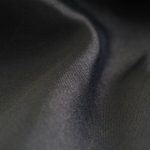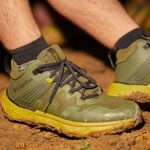You can wear Gore-Tex in hot weather since it breathes and wicks moisture to keep you dry, but its waterproof membrane may trap heat during heavy sweating. It offers durability and water protection but can be less ventilated than lighter fabrics, which might cause discomfort in intense heat. For better airflow, you might prefer alternatives designed specifically for warm conditions. Keep exploring to find out how Gore-Tex stacks up and when it’s your best choice.
Table of Contents
Key Takeaways
- Gore-Tex offers waterproof protection with breathability that manages moisture but may trap heat in intense hot weather.
- Its microporous membrane allows sweat vapor to escape, helping regulate temperature during moderate warm conditions.
- In high heat and heavy sweating, Gore-Tex can become less comfortable due to reduced airflow and slower drying.
- Lightweight Gore-Tex variants like Paclite improve comfort but still don’t match the ventilation of hot-weather-specific fabrics.
- Alternatives like eVent or Polartec NeoShell provide better breathability and airflow for hot weather compared to Gore-Tex.
Understanding Gore-Tex Technology
Although Gore-Tex is known primarily for its waterproof capabilities, it’s important to understand how its unique membrane works to keep you dry and comfortable.
The membrane contains microscopic pores that are small enough to block water droplets from entering but large enough to allow water vapor, like sweat, to escape. This selective barrier means you stay protected from rain while still letting your body breathe.
When you wear Gore-Tex gear, you benefit from this balance of protection and ventilation. The membrane is laminated between fabric layers, adding durability without sacrificing flexibility.
How Gore-Tex Manages Moisture and Heat
You’ll appreciate how Gore-Tex uses moisture-wicking technology to keep sweat moving away from your skin.
Its breathability helps you stay comfortable even when the temperature rises.
Let’s explore how these features work together to regulate heat effectively.
Moisture-Wicking Technology
Gore-Tex uses advanced moisture-wicking technology to keep you dry and comfortable by efficiently managing sweat and heat. When you sweat, the fabric pulls moisture away from your skin, moving it toward the outer layer where it can evaporate quickly.
This process prevents sweat from pooling on your skin, reducing discomfort and the risk of chafing. The technology relies on microscopic pores that are small enough to block rain but large enough to let moisture escape.
As a result, you stay drier during physical activities, even in warm conditions. While Gore-Tex isn’t designed specifically for extreme heat, its moisture-wicking capability helps regulate your body’s temperature by managing sweat effectively, making it a reliable choice when you need protection from the elements without sacrificing comfort.
Breathability in Warm Conditions
When temperatures rise, staying cool and comfortable becomes a priority, and breathable fabrics play a key role in achieving this. Gore-Tex manages moisture and heat by allowing sweat vapor to escape while blocking external water, helping you stay dry without overheating.
Here’s how Gore-Tex handles breathability in warm conditions:
- Microporous membrane lets moisture vapor out but keeps liquid water from entering.
- Fabric layers work together to promote airflow and reduce trapped heat.
- Sweat vapor moves from your skin to the outer layers, preventing dampness inside.
- Durable water repellent (DWR) coating helps maintain breathability by shedding surface moisture.
Heat Regulation Mechanisms
Managing breathability is just one part of staying comfortable in the heat; understanding how Gore-Tex controls moisture and temperature adds another layer of insight.
Gore-Tex uses a microporous membrane that allows water vapor from your sweat to escape while blocking liquid water from entering. This means you stay dry without overheating. When your body heats up, moisture moves through the tiny pores, preventing sweat buildup that causes discomfort.
The membrane’s structure also helps regulate your temperature by balancing heat retention and release. However, in extreme heat, this system can sometimes struggle to keep up if you’re very active.
Still, Gore-Tex’s design aims to keep you as comfortable as possible by managing moisture and heat efficiently, making it a practical choice for many warm-weather activities.
Benefits of Wearing Gore-Tex in Warm Climates
You’ll appreciate how Gore-Tex’s breathability keeps air flowing, so you stay cool even when it’s hot.
Its moisture management pulls sweat away from your skin, preventing discomfort and irritation.
Plus, the lightweight design means you won’t feel weighed down during your warm-weather activities.
Breathability Features Explained
Although Gore-Tex is often associated with cold and wet conditions, its breathability features make it surprisingly effective in hot weather. When you wear Gore-Tex, it allows sweat vapor to escape while keeping rain and moisture out. This balance helps you stay cooler and more comfortable during intense heat.
Here’s why Gore-Tex breathability benefits you in warm climates:
- Microporous membrane vents sweat vapor efficiently.
- Waterproof outer layer blocks external water without sacrificing airflow.
- Enhanced ventilation reduces heat buildup inside your gear.
- Lightweight design prevents overheating during physical activity.
Moisture Management Benefits
Because Gore-Tex efficiently controls moisture, it keeps you dry and comfortable even in hot weather.
When you sweat, Gore-Tex lets that moisture escape, preventing it from pooling inside your clothing. This means you won’t feel clammy or weighed down by damp fabric.
The fabric’s membrane blocks external water while allowing sweat vapor to pass through, maintaining a balanced microclimate next to your skin. This moisture management reduces the risk of chafing and irritation, which can be common problems when working or exercising in the heat.
Lightweight Comfort Advantages
A key advantage of Gore-Tex in warm climates is its lightweight design, which enhances comfort without sacrificing performance.
When you wear Gore-Tex gear, you’ll notice it feels less bulky, allowing for better mobility and less fatigue during outdoor activities. Its breathable fabric also helps regulate your body temperature, preventing overheating.
Plus, Gore-Tex materials dry quickly, so you stay comfortable even if you sweat or encounter light rain.
Here are four lightweight comfort benefits you’ll appreciate in warm weather:
- Reduced weight for easier movement
- Enhanced breathability to avoid overheating
- Quick-drying fabric to stay comfortable
- Durable protection without added bulk
These features make Gore-Tex a practical choice when you want comfort and protection under the sun.
Potential Drawbacks of Gore-Tex in Hot Weather
When you wear Gore-Tex in hot weather, you might notice it doesn’t always offer the comfort you expect. While it’s great at keeping rain out, its breathability can struggle when temperatures soar and you sweat heavily.
You may feel stuffy or overheated because moisture sometimes gets trapped inside, making the fabric less effective at cooling you down. Plus, Gore-Tex garments often have multiple layers, which can add weight and reduce airflow compared to simpler fabrics.
If you’re active in intense heat, this can increase discomfort and fatigue. Also, Gore-Tex tends to dry slower if it does get wet from sweat, leaving you feeling clammy.
Comparing Gore-Tex to Other Breathable Fabrics
When choosing gear for hot weather, you’ll want to compare Gore-Tex with other breathable fabrics on key factors like moisture-wicking efficiency and air permeability.
You’ll also need to contemplate durability and how comfortable each material feels against your skin.
Understanding these differences will help you pick the best option for staying cool and dry.
Moisture Wicking Efficiency
Although Gore-Tex excels at keeping water out, it doesn’t always wick moisture as efficiently as some other breathable fabrics designed specifically for hot weather.
When you’re active in heat, effective moisture wicking is vital to stay comfortable and dry. Fabrics like polyester blends, nylon, and specialized synthetics often outperform Gore-Tex in moving sweat away from your skin quickly.
Here’s how Gore-Tex stacks up in moisture wicking efficiency:
- Gore-Tex relies mainly on membrane breathability, which slows moisture transfer compared to wicking fibers.
- Polyester and nylon fabrics use capillary action to pull sweat away faster.
- Some hot-weather fabrics have chemical treatments enhancing moisture transport better than Gore-Tex.
- Gore-Tex prioritizes waterproofing, sometimes compromising rapid moisture wicking.
Air Permeability Levels
Because air permeability directly affects how well a fabric ventilates, it plays an essential role in comfort during hot weather.
Gore-Tex, known for its waterproof qualities, has lower air permeability compared to many lightweight, breathable fabrics like mesh or nylon blends. This means less air passes through Gore-Tex, reducing ventilation.
If you’re hiking or running in the heat, you might find Gore-Tex traps more heat and sweat than other fabrics designed specifically for breathability.
Fabrics like eVent or certain polyester mixes offer higher air permeability, allowing more airflow and better cooling.
Durability and Comfort
While Gore-Tex may not offer the best airflow for hot weather, it stands out in durability and long-term comfort compared to many breathable fabrics.
When you choose Gore-Tex, you get a tough outer layer that resists tears and abrasions, making it ideal for rugged activities. It also maintains its waterproof and breathable qualities over time, so you won’t have to replace your gear frequently.
Plus, Gore-Tex adapts well to changing conditions, keeping you comfortable whether you’re sweating or facing light rain.
Consider these points:
- Gore-Tex resists wear better than many lightweight breathable fabrics.
- It retains waterproof and breathability features longer.
- Its comfort lasts through varied weather.
- It balances protection and ventilation for active use.
This makes Gore-Tex a reliable choice despite its airflow limits.
Best Gore-Tex Gear for Summer Activities
Choosing the right Gore-Tex gear can make a big difference in staying comfortable during summer activities. Look for lightweight Gore-Tex fabrics designed specifically for warm weather.
Jackets labeled as Gore-Tex Paclite or Active offer breathability without sacrificing waterproof protection, making them ideal for hiking or running on hot days. Gore-Tex gloves with mesh panels help keep your hands cool while still repelling water.
Gore-Tex Paclite jackets and mesh-paneled gloves keep you cool and dry on hot, active days.
For footwear, pick Gore-Tex hiking shoes with ventilated uppers to prevent overheating and moisture buildup. Avoid bulky or heavily insulated Gore-Tex items that trap heat.
Instead, focus on gear that balances waterproofing with ventilation, so you stay dry without feeling stifled. By choosing summer-specific Gore-Tex gear, you’ll enjoy reliable weather protection while keeping cool and comfortable.
Tips for Staying Cool While Wearing Gore-Tex
Staying cool in Gore-Tex gear involves more than just picking the right fabric—it’s about how you wear and manage your layers.
To keep comfortable in warm conditions, focus on ventilation, moisture control, and strategic layering.
- Use Gore-Tex jackets with pit zips or ventilation panels to boost airflow.
- Wear moisture-wicking base layers that pull sweat away from your skin.
- Avoid over-layering; keep your outfit minimal and breathable.
- Take breaks in shaded or cooler areas to prevent overheating.
User Experiences With Gore-Tex in Hot Conditions
Although Gore-Tex is praised for its waterproof and breathable qualities, many users find its performance in hot weather varies depending on activity and environment. You might notice that during high-intensity activities, Gore-Tex can feel less breathable, causing discomfort. Conversely, in moderate heat with lower exertion, it often manages moisture effectively. User feedback highlights both benefits and drawbacks, emphasizing how your experience can shift based on conditions.
| Activity Type | User Feedback | Comfort Level |
|---|---|---|
| Hiking | Breathable but can trap heat | Moderate |
| Running | Less breathable, causes sweating | Low |
| Casual Walking | Comfortable in mild heat | High |
| Rainy Hot Days | Keeps dry, decent breathability | Moderate to High |
| Extended Wear | Can feel clammy after hours | Low to Moderate |
Alternatives to Gore-Tex for Hot Weather Adventures
When you face hot weather adventures, you’ll want gear that offers breathability without sacrificing protection. Gore-Tex can sometimes feel too warm, so consider these alternatives:
- eVent Fabric – Known for its Direct Venting™ technology, it maximizes breathability while keeping water out.
- Pertex Shield – Lightweight and breathable, ideal for warm conditions with light rain.
- Polartec NeoShell – Balances waterproofing with superior airflow, perfect for active pursuits.
- Soft-shell Jackets – Typically water-resistant and highly breathable, they offer comfort in dry, hot climates without overheating.
These options help you stay cool and dry, making your hot weather adventures more enjoyable without the bulk or heat buildup of Gore-Tex.
When to Choose Gore-Tex Over Other Materials
While alternatives to Gore-Tex offer excellent breathability for hot weather, there are situations where Gore-Tex remains the better choice.
If you’re facing unpredictable weather with sudden rain or storms, Gore-Tex’s waterproof protection will keep you dry without sacrificing too much ventilation.
When you’re tackling rugged terrain or lengthy hikes, durability becomes essential—Gore-Tex holds up better under abrasion and rough use compared to lighter materials.
Also, if you prioritize staying dry over maximum airflow, Gore-Tex’s reliable waterproofing is worth the slight trade-off in breathability.
In short, choose Gore-Tex when you need dependable weather protection, durability, and are prepared for varying conditions.
For more stable, hot, and dry climates, lighter, more breathable fabrics might serve you better.
Frequently Asked Questions
Can Gore-Tex Be Washed in a Regular Washing Machine?
You can wash Gore-Tex in a regular washing machine, but use cold water and a gentle cycle. Avoid fabric softeners and bleach. Rinse thoroughly, then tumble dry on low to restore its waterproof properties effectively.
Does Gore-Tex Fabric Fade or Lose Color Over Time?
You won’t usually see Gore-Tex fabric fading or losing color quickly since it’s designed to be durable. However, repeated exposure to sunlight and harsh washing can gradually dull its appearance over time.
Is Gore-Tex Environmentally Friendly or Recyclable?
You might think Gore-Tex isn’t eco-friendly, but it’s made with durable materials designed to last, reducing waste. While recycling options are limited, the company’s committed to improving sustainability and reducing environmental impact over time.
How Long Does Gore-Tex Typically Last With Regular Use?
You can expect Gore-Tex to last several years with regular use, typically around 5 to 10 years. Proper care, like cleaning and reproofing, helps maintain its waterproof and breathable performance over time.
Can Gore-Tex Be Repaired if It Gets Torn or Damaged?
You can repair Gore-Tex if it gets torn or damaged. Using specialized patches or repair kits designed for waterproof fabrics helps restore its function. Just make sure to follow the instructions carefully for the best results.
- Does Chiffon Fabric Stink - July 15, 2025
- Does Chiffon Fabric Affect the Economy - July 15, 2025
- Does Cotton Fabric Have a Nap - July 15, 2025







